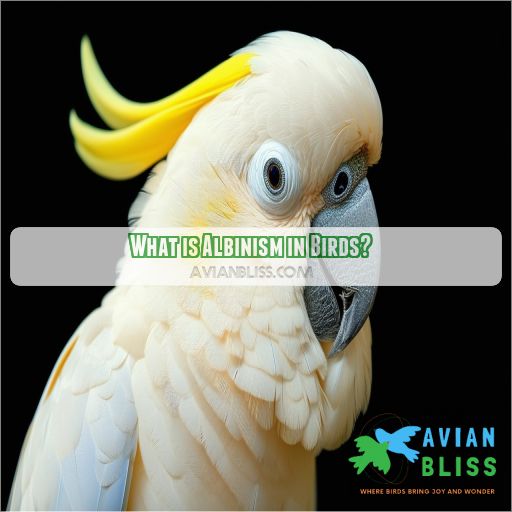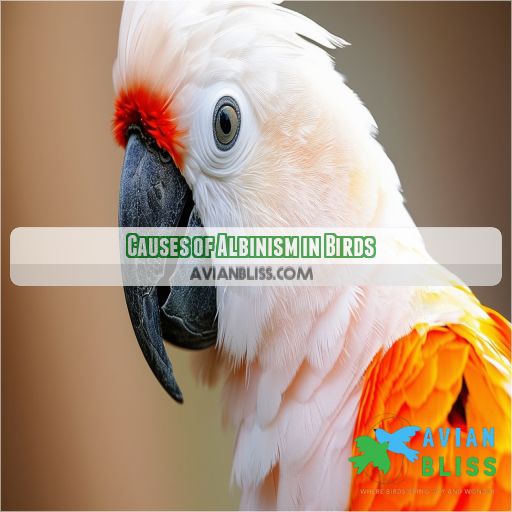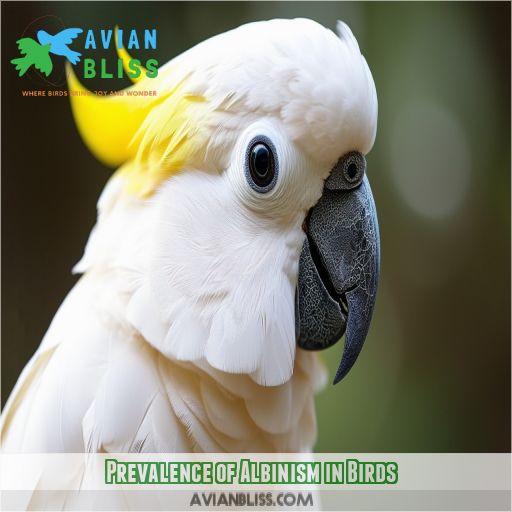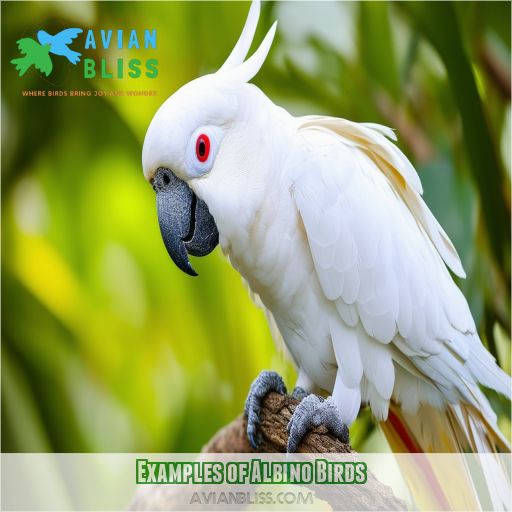This site is supported by our readers. We may earn a commission, at no cost to you, if you purchase through links.

While beautiful, these birds face challenges like increased predation risks and potential health issues. Albinism in parrots can be complete or partial, with some birds lacking pigment in only certain body parts.
It’s primarily caused by genetic inheritance patterns, but environmental factors may play a role too.
If you’re fascinated by these snow-white beauties, you’ll want to explore the intriguing world of albino parrots and their special needs.
Table Of Contents
- Key Takeaways
- What is Albinism in Birds?
- Types of Albinism in Birds
- Causes of Albinism in Birds
- Prevalence of Albinism in Birds
- Challenges Faced by Albino Birds
- Examples of Albino Birds
- Conservation Efforts for Albino Birds
- Caring for Albino Birds in Captivity
- Frequently Asked Questions (FAQs)
- Do albino parrots exist?
- How much does an albino Quaker parrot cost?
- Are albino parrotlets rare?
- Are albino parakeets rare?
- Can albino parrots see color?
- Do albino parrots have different dietary requirements?
- Are albino parrots more expensive than regular parrots?
- Can albino parrots breed with non-albino parrots?
- Do albino parrots have a different lifespan?
- Conclusion
Key Takeaways
- Albino parrots are the unicorns of the bird world – striking white feathers and pink eyes make them stand out like a sore thumb, but they’re rarer than hen’s teeth due to their recessive genes.
- These snowy beauties face an uphill battle – increased predation risks and potential health issues mean life’s no walk in the park for our pale-feathered friends.
- Not all that glitters is gold (or in this case, white) – some mutations like lutino can create similar appearances without being true albinos. It’s enough to ruffle anyone’s feathers!
- Caring for albino birds is a delicate dance – they need extra TLC, from protection against sunburn to special socialization. It’s like having a feathered snowflake that needs its own weather forecast!
What is Albinism in Birds?
You’ve probably seen white birds before, but have you ever encountered an albino parrot? Albinism in birds is a rare genetic condition that results in a complete lack of melanin, the pigment responsible for feather, skin, and eye color. Unlike leucism, which causes partial loss of pigmentation, albinism affects the entire body. Albino birds stand out with their striking white plumage and pink or red eyes, a result of visible blood vessels.
This condition stems from a recessive gene, meaning both parents must carry it for offspring to be albino. While visually stunning, albinism comes with challenges. These birds often face increased predation risks and potential health issues. The ino gene, responsible for albinism, can also cause other genetic flaws. Notably, some mutations like lutino and turquoise creamino can create similar white appearances without being true albinos. Understanding albinism helps us appreciate these rare beauties in the avian world.
Types of Albinism in Birds
You’ve learned about albinism in birds, but did you know there are different types? Let’s explore the fascinating world of albino plumage and its variations. Albinism isn’t a one-size-fits-all condition; it comes in various forms, each with unique characteristics.
- Complete albinism: Birds lack all pigmentation, resulting in white feathers and pink eyes.
- Partial albinism: Only certain body parts lack pigment, creating a patchy appearance.
- Leucism: Similar to albinism but with some pigment retention, often resulting in pale coloration.
These genetic conditions can lead to striking phenotype variations in birds. While albino parrots and leucistic birds may catch your eye, it’s important to understand the breeding implications and health considerations associated with these traits. Imperfect plumage doesn’t just affect feather colors; it can impact a bird’s overall well-being. As we investigate deeper, you’ll gain a better understanding of these unique avian beauties.
Causes of Albinism in Birds
You’ll find that albinism in birds is primarily caused by genetic inheritance patterns, with recessive genes typically responsible for this rare condition. Environmental factors may also play a role in triggering albino mutations, though their exact influence is still being studied by researchers.
Genetic Inheritance Patterns
Now that you’re familiar with albinism types in birds, let’s delve into genetic inheritance patterns. These patterns play a pivotal role in determining whether a parrot will be albino. Here’s a breakdown of key inheritance factors:
| Inheritance Type | Description | Example | Impact |
|---|---|---|---|
| Recessive | Requires two copies | Albino budgies | Rare occurrence |
| Incomplete dominance | Partial expression | Pink-tinted albinos | Varied phenotypes |
| X-linked | Affects males more | Male albino parrots | Breeding challenges |
Understanding these patterns aids breeders in addressing ethical implications and bird care considerations.
Environmental Factors Influence
While genetic factors play a significant role, environmental influences can also impact albinism in birds. You’ll find that these external factors can contribute to the appearance of albino traits:
- Dietary deficiencies affecting pigment production
- Excessive sunlight exposure altering melanin synthesis
- Temperature fluctuations disrupting feather development
These factors may interact with genetic predispositions, resulting in the striking appearance of pink parrots with red eyes, pink legs, and large beaks. Understanding these influences helps us better care for and appreciate these rare beauties.
Mutation Types Comparison
While environmental factors play a role, genetic mutations are the primary cause of albinism in birds.
Lutino vs albino mutations produce different color variations. Blue vs turquoise mutations can create stunning hues, but mutation combinations may lead to genetic flaws.
Like diamond rhinestones on a sticky canvas, these color variations make bird identification fascinating.
Understanding these mutations is essential for budgie healthcare and enhancing their social life.
Prevalence of Albinism in Birds
You might be surprised to learn that albinism in birds is relatively rare, occurring in about 1 in 1,800 individuals across species. This scarcity is due to several factors, including:
- Genetic linkage to other traits that may reduce survival
- Higher chick mortality rates in albino birds
- Increased vulnerability to predators due to lack of camouflage
- Potential vision problems associated with albinism
While albinism is uncommon, you’ll find that other color mutations, like lutino or blue varieties, are more prevalent in the avian world. These mutations can create stunning color combinations, much like a living diamond painting. Breeders often use a diamond pen to carefully select for new mutations, expanding the palette of possibilities. In budgies, you’ll see a range from the green series variety to the blue of the masculine budgie. Remember, providing fresh greens is vital for all birds, regardless of their color mutation.
Challenges Faced by Albino Birds
Now that you understand how rare albino birds are, let’s explore the unique challenges they face. These snow-white beauties may catch your eye, but their striking appearance comes at a cost.
| Challenge | Impact |
|---|---|
| Predation | Increased visibility |
| Sun damage | Lack of pigment protection |
| Vision problems | Reduced depth perception |
| Social issues | Rejection by flock |
The albino gene affects more than just feather color. You’ll notice these birds often struggle with environmental impacts that their colorful counterparts don’t face. Their lack of pigmentation leaves them vulnerable to sun damage and predators. Ever wondered why you don’t see many albino birds in the wild? It’s because their survival rate is much lower.
Conservation measures are important for these unique creatures. Breeding challenges make it difficult to maintain albino populations, especially in captivity. Understanding these hurdles is key to protecting these rare avian gems.
Examples of Albino Birds
While albino birds face challenges, they’re still a sight to behold. You might spot an albino robin hopping in your backyard, its pure white plumage a stark contrast to its red-breasted cousins.
In the realm of aviculture, albino budgerigars and cockatiels are more common, their snowy feathers and pink eyes enchanting bird enthusiasts. Albino genetics play a pivotal role in their appearance, but it’s their behavior that often sets them apart. They may be more cautious due to reduced eyesight.
If you’re into bird watching, keep an eye out for these rare beauties. Proper albino care is essential, as they require extra protection from sunlight. Their lifespan can be shorter, so albino breeding should be approached with caution.
Conservation Efforts for Albino Birds
After exploring examples of albino birds, you might wonder about conservation efforts for these unique creatures. Tracking albino populations is important, as their rarity makes them vulnerable. Researchers collaborate to monitor these special birds, much like you’d keep an eye on a pair of parrots in your home.
Habitat protection is key, guaranteeing albinos have safe spaces to thrive, just as you’d provide safe toys for your budgie. Maintaining genetic diversity is another focus, helping prevent the "bottleneck" effect of a limited gene pool.
Public awareness campaigns play a significant role, educating people about these rare beauties – think of it as sharing pink flamingos with the world. By understanding and appreciating albino birds, we’re not just preserving a genetic quirk, but celebrating nature’s diversity.
It’s a collective effort to ensure these feathered wonders continue to grace our skies.
Caring for Albino Birds in Captivity
Caring for albino birds in captivity requires special attention to their unique needs. You’ll need to provide a diet rich in vitamins and minerals, especially vitamin D, to compensate for their sensitivity to sunlight.
Housing requirements are essential; make sure their enclosure offers protection from direct sunlight while still allowing for natural light exposure.
Socialization can be tricky, as albino birds may face rejection from other birds. Introduce them cautiously and monitor interactions closely.
Keep a watchful eye on their health, as they’re prone to vision and skin issues. Regular check-ups with an avian veterinarian are necessary to catch any problems early.
Frequently Asked Questions (FAQs)
Do albino parrots exist?
Like finding a needle in a haystack, true albino parrots are extremely rare. While you’ll often hear about "albino" parrots, they’re usually lutino mutations. True albinism in parrots is possible but exceptionally uncommon in nature.
How much does an albino Quaker parrot cost?
You’ll find that albino Quaker parrots are quite rare. Their cost can vary widely, typically ranging from $500 to $2, Prices depend on the breeder, bird’s age, and health. Always research reputable sources before purchasing.
Are albino parrotlets rare?
While you might think albino parrotlets are common, they’re actually quite rare. You’ll find it challenging to locate one. Albinism in parrotlets is a recessive trait, making these pure white, red-eyed birds uncommon in avian circles.
Are albino parakeets rare?
You’ll find that albino parakeets are quite rare. They’re not as common as standard green or blue budgies. Their striking all-white plumage and pink eyes make them stand out, but true albinos are hard to come by.
Can albino parrots see color?
You might wonder if albino parrots see color. They can’t. Their lack of pigment affects their vision, leaving them colorblind. They rely on other senses to navigate their world, adapting uniquely to their environment.
Do albino parrots have different dietary requirements?
You’ll find that albino parrots generally don’t need a special diet. Their nutritional requirements are the same as other parrots. However, they might be more sensitive to sunlight, so you should make certain they’ve adequate vitamin D supplementation.
Are albino parrots more expensive than regular parrots?
Avian enthusiasts may find that these feathered friends with special pigmentation come at a premium. You’ll likely shell out more for these unique beauties, as their rarity and distinctive appearance often command higher prices in the pet market.
Can albino parrots breed with non-albino parrots?
Yes, albino parrots can breed with non-albino parrots. The albino gene is recessive, so offspring may not show the trait. You’ll need to understand genetics to predict outcomes. Breeding albinos requires careful consideration due to potential health issues.
Do albino parrots have a different lifespan?
You’ll find that albino parrots often have shorter lifespans due to health issues linked to their genetic mutation. They’re more susceptible to eye problems, skin cancer, and other complications that can impact their longevity compared to non-albino parrots.
Conclusion
From snow-white feathers to pink eyes, albino parrots captivate our imagination. You’ve learned about their genetic origins, challenges, and care needs.
Whether in the wild or captivity, these rare birds require special attention. By understanding albinism in birds, you’re better equipped to appreciate and support these unique creatures.











